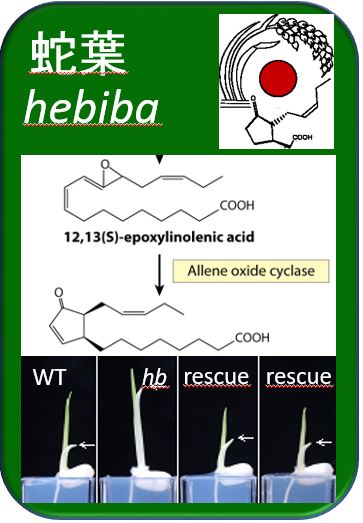The hebiba mutation has been elucidated
Publication
95. Riemann M, Haga K, Shimizu T, Okada K, Ando S, Mochizuki S, Nishizawa Y, Yamanouchi U, Nick P, Yano M, Minami E, Takano M, Yamane H, Iino M (2013) Isolation of Rice ALLENE OXIDE CYCLASE mutants and the function of jasmonate for defence against Magnaporthe oryzae. Plant J 74, 226-238 - pdf
(136 quotations, 13.6 p.a., state 17.02.2022)
What is the topic?
During the search for signals that control the growth response to light, we discovered 1991 in Japan a rice mutant that at first glance appeared to be blind. At a second glance it turned out to see the light, but to interpret it as dark. This mutant was termed hebiba (Japanese for "snake leaf") due to its long and creeping leaves. Ten years later, we found that the mutant was not able to produce the hormone jasmonic acid (Riemann et al. 2003). Before, jasmonic acid had been known as wound signal. The surprising phenotype of the hebiba mutant led us to understand jasmonic acid as central regulator for stress adaptation. Which gene was affected in the mutant, was not clear, however. The hebiba had been generated by gamma rays in the so called Gamma-Fierudo of the Japanese Ministry for Agriculture, Forestry and Fishery, a huge area in a forest North of Tokyo, where a gigantic cobalt bomb is exposing experimental plants cultivated in this field. Cobalt rays often delete entire gene pieces, sometimes even several genes at a time. As a result, one gets not only base exchanges, but also deletions.
The paper tells now the path from the mutant phenotype to the mutant gene. In reality, this path lasted for several years and become only possible by intensive cooperation between German and Japanese scientists. First, the hebiba mutant was crossed with a strongly differing rice variety from India, Kasalath to generate a large progeny of quite different individuals. Each individual got different chromosomes or parts from the mutant. Since hebiba was made in the background of the Japanese rice variety Nihonmasari, many genetical differences between the two parent varieties were known and if one is now looking at those individuals that show the hebiba-phenotype (these are seedlings with long coleoptiles although grown under light), one can use PCR targeted to the parent specific markers to find out, which chromosome region from the Japanese parent is present. This allows to pin down the location of the mutation in the rice genome. At the end it turned out that in hebiba a chromosome piece was lacking, where ten different genes are located. Among them the gene for Allene Oxid Cyclase, a central enzyme for the synthesis of jasmonic acid. This gene was therefore a hot candidate, but the proof that the curious phenotype of the mutant was really caused by the absence of this enzyme, was still to be conducted:
For this goal, the intact version of Allene Oxid Cyclase was isolated from the wild type and introduced into the mutant genome using Agrobacterium tumefaciens. The resulting transgenic plants recovered the ability to respond normally to light - their coleoptiles were short in the light, long in the dark, just as normally in rice (in the mutant, they behave exactly the other way round). This demonstrated that the gene for Allene Oxid Cyclase was necessary and sufficient for a normal light response. In addition to hebiba we were able to find a second mutant affected in the same gene, coleoptile photomorphogenesis 2. Here, only a small piece (11 base pairs) was missing, but also this mutant was mixing up light and dark and could be "rescued" by an intact version of the Allene Oxid Cyclase gene. Such a "rescue" is used as important evidence that a certain mutation in a given gene is really responsible for the observed phenotype.

